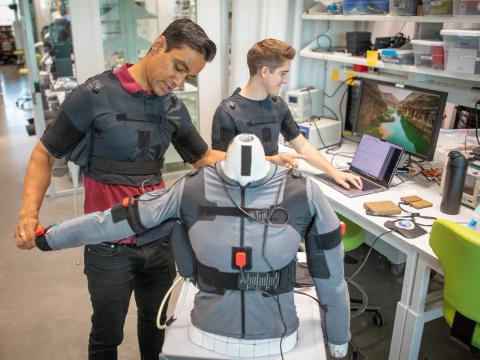Artificial Intelligence 101
With the explosion of artificial intelligence onto the computing scene again, the hype about the technology continues to grow. Making sense of how to employ artificial intelligence (AI) and machine learning (ML) can still be difficult, however, experts reasoned Monday at the AI World Government conference, held in Washington, D.C., June 24-26.
Ron Schmelzer and Kathleen Walch, who both are managing partners and principal analysts at Cognilytica, shared insights from their work reviewing and interpreting the AI marketplace—which includes a weekly podcast called AI Today.
“AI is transforming the way we work, live and interact together, but putting it into the practice is more difficult than it may seem,” Schmelzer said. AI will support future enterprise systems that are both intelligent and autonomous for an “always-on workforce,” the managing partners stressed.
AI has been through two winters, or times of falling interest and investment, and “now it is back into vogue…. and we hope this time around it sticks,” Walch added.
While industries and organizations are already experiencing changes due to employing the advanced computer systems, AI doesn’t make a use case for everything, the experts said.
According to Schmelzer and Walch, AI and other cognitive or intelligent technologies are best suited for tasks or problems involving classification and identification, such as object identification and clustering or for conversational interfaces that use text or voice chatbots. AI does well with performing predictive analytics using big data, or using structured data to make inferences; pattern discovery to find hidden patterns in big data; or on autonomous systems, robotic or other systems that run independently, without human interaction. In addition, AI is well-suited for game and scenario playing, or letting computer systems discover hidden rules; or for providing hyper-personalization and recommendations, connecting pieces of information to make a larger conclusion to serve customers or users more effectively.
Schmelzer shared a hyper-personalization use case example from McDonald's, which had an AI company look at how the fast food company can, among other things, personalize the menu as customers go through the drive-thru. A license plate reader would scan a customer’s car in line, identify them and offer specific menu choices based on the customer’s preferences, he noted.
Notably, the Cognilytica analysts have found that most applications of AI center around information technology activities, such as using AI in cybersecurity to detect and prevent intrusions; automating production management work; measuring internal compliance when relying on approved technology vendors; and automating runbook or routine system administrator operations. Companies are also using AI to enhance their media buying practices; monitor social media traffic for brand or market research; and automate call distribution activity.
Schmelzer and Walch also advised when not to use AI. Advanced cognitive systems are not suited for repetitive, deterministic automation tasks; or systems that require 100% accuracy; or formulaic analytics, which are better performed by business intelligence platforms.
In addition, AI will not work “in situations with very little training data,” Walch noted. “If you can’t train a system, then machine learning won’t work.” And sometimes, just having a human perform a task when it is easier, cheaper and faster, is the better choice, she said.
As the analysts look at AI use cases across the industry, they see recurring patterns, Schmelzer shared. Generally, AI is being used in seven ways, namely for:
- hyper-personalization,
- recognition,
- patterns and anomalies,
- autonomous systems,
- goal-driven systems,
- conversation and human interaction, and
- predictive analytics and decisions.
“You need to understand what each pattern is so you know which patterns you need,” when planning to use AI systems, Walch advised.
In addition, it is common to have multiple applications of AI within one system. For example, assistant-enabled commerce, which relies on collaborative robots known as cobots to interact with customers, would include the use of AI hyper-personalization, autonomous, and conversation and human interaction systems.
When outsourcing for AI, or employing AI as a service, Schmelzer and Walch cautioned that users need to look at which type of AI services they require, since the playing field “is a large mishmash.” Already, the field has more than 3,000 possible AI vendors.
The experts categorize four types of AI vendors: (1) companies that provide AI and machine learning infrastructure, such as data labeling or compute resources needed to run AI algorithms; (2) companies that offer AI-enabling technologies, such computer vision, natural language processing; (3) companies that provide horizontal applications of AI, applications that span multiple sectors, such as chat bots or virtual assistants; or (4) companies that provide vertical applications of AI, which are industry specific.
“The major of AI companies fall into this latter category,” Walch noted.
Arti Garg, an emerging market and technology director at Cray, who also spoke at the conference, advised that to implement AI successfully, users need to clearly identify the problem that AI will solve. “The path to AI success does not always run straight,” she said. “Ninety percent of AI projects fail because you didn’t define the problem. You need to define a clear problem and find one that has value also to your agency. And don’t treat AI as a destination.”
Before running an AI platform, organizations may need to solve other issues first. “Think about the data you have, is it enough or is it in the right format,” Garg asked. “Once you have the data that you need, then you can start to build an AI solution.”
She shared an AI use case from the U.S. Geological Society (USGS), which her company built to support USGS agency-wide data science advancements. The agency’s scientists want to improve the models they use, which include anything from identifying fish species to predicting wildfire hazards. “They have tons of data, 14 petabytes of data from multiple sensors and nationwide sources,” said Garg.
The USGS chose a tailored AI computing system to be co-located within USGS in order to make use of their data. They purchased from Cray a suite of advanced AI software tools.
“USGS needed it to run quickly, and where the computer sat was really important to them,” Garg said.
Schmelzer added that while AI is an immature field right now, it will become commonplace. “While we are asking, ‘Are you doing AI?’ now, in few years it will seem like a funny question, like asking if you are on the Internet.”
Moreover, he continued, AI, as a transformative technology, will continue to draw a steady flow of investment from venture capitalists. New companies continue to enter the marketplace, Schmelzer said.





Comments